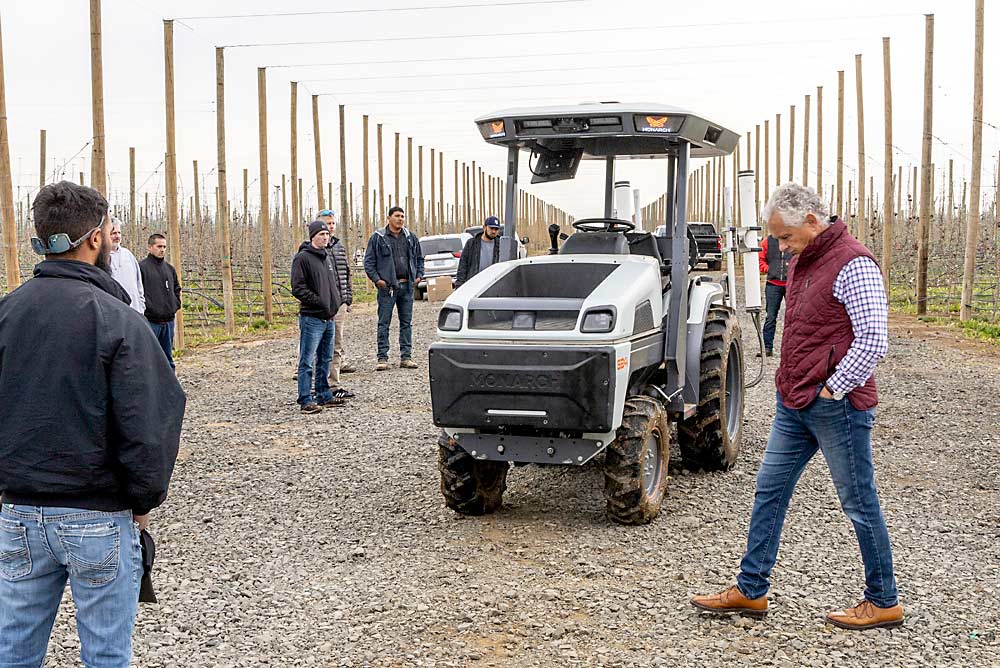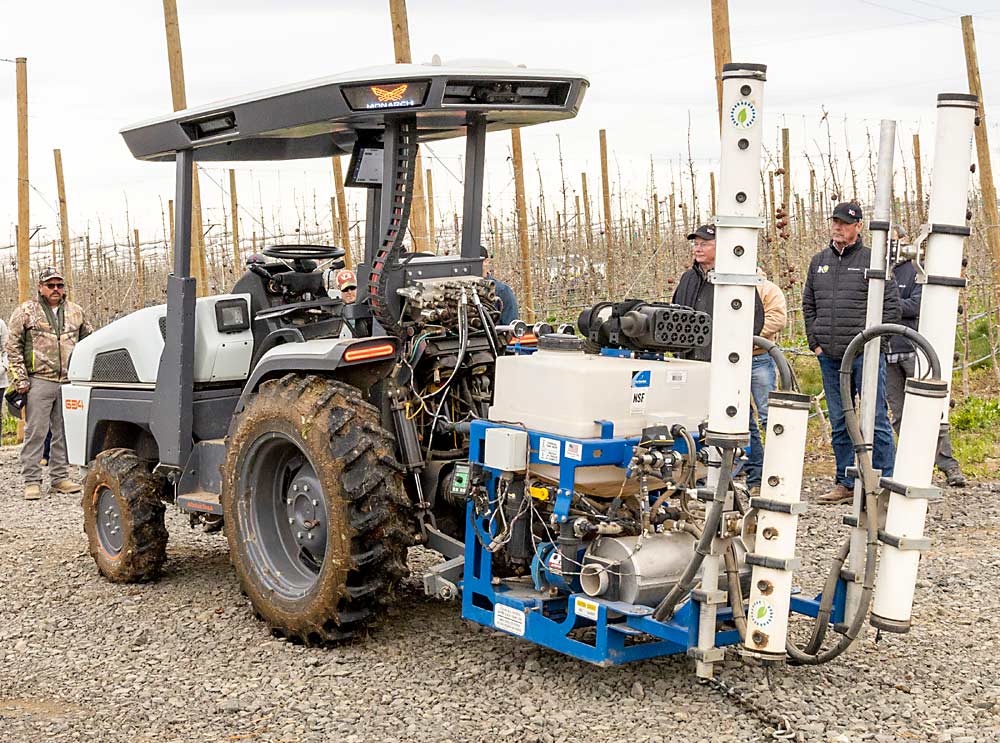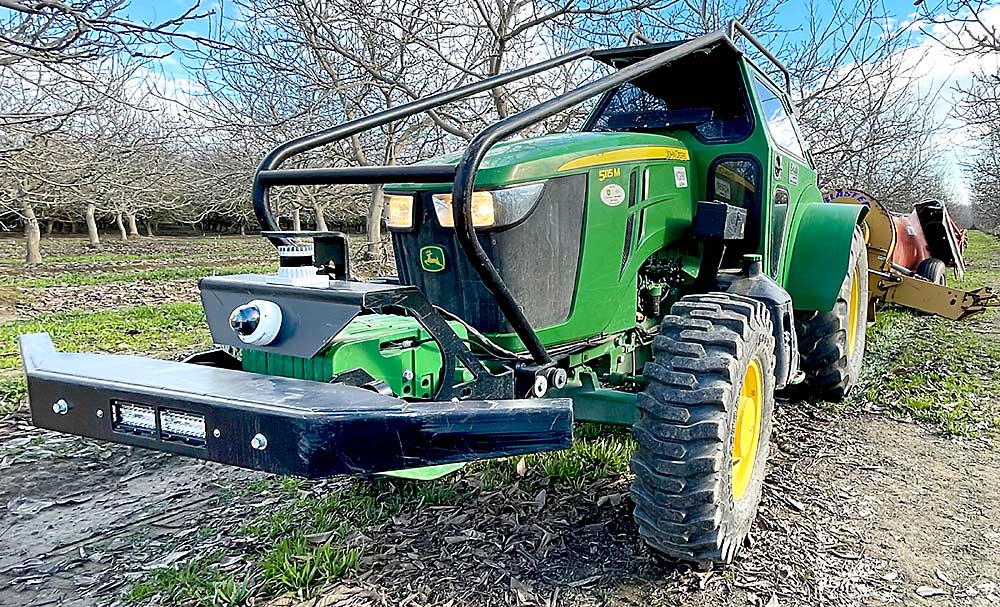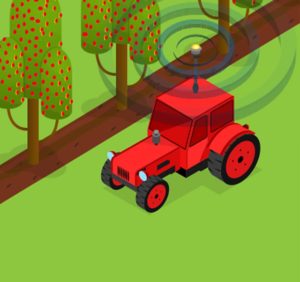
No one drove the tractor at the demo.
Even so, it navigated smoothly and quietly up and down the rows of a high-density apple orchard in Washington’s Columbia Basin, impressing the gathered growers interested in automating routine orchard tasks such as mowing and spraying.
“You can take your best tractor driver and make him a fleet manager and reduce your labor costs at the same time you can decrease your greenhouse gas emissions,” Monarch Tractor CEO Praveen Penmetsa said. The California-based company focused on designing an all-electric tractor to fit in narrow orchards and vineyards.
There’s a rush to commercialize autonomous technology across the agriculture sector, and Monarch is one of two companies launching tractor technology specifically targeting the tree fruit and grape industries this year. The other, Blue White Robotics, offers an aftermarket kit that turns a farm’s existing tractors into a fleet that can be operated remotely. Both already have customers in California and have conducted demonstrations in Washington.
Monarch bills its $58,000 tractor as driver-optional; the efficient, sustainable electric power alone attracted some customers. It’s the electric power approach that sets the stage for automation and digital data collection, Penmetsa said. It can also act as its own power source for remote work, so no need to haul a generator to the field.
“If you are comparing our tractor to a 40-horsepower tractor, there’s no compromise,” Penmetsa said. “Our goal when we started off on this journey was to meet the tightest demands from the orchard and vineyard and berry markets.”
In fact, the company wanted to show farmers that when you go electric, the standard relationship between power and size no longer applies. The Monarch tractor offers 40 to 70 horsepower in the size class typical for a 20 horsepower tractor. It has 50 percent more torque than a typical 40 horsepower tractor and 20 percent more hydraulic power. Beyond the typical tractor specs, Penmetsa said Monarch will make data-driven farming more efficient.
“While you are doing your operations, the cameras can collect the data,” he said. That data can automate spray records, for example, and Monarch is collaborating with several other companies that use imagery data to assess yield or scout for pests and disease.

Wente Vineyards, in Livermore, California, opened its farm to Monarch for testing a few years ago and now owns two of the first commercial tractors, said viticulture manager Niki Wente. They bought the tractors in June with financial support from a grant program for zero-emission farm equipment.
“We are a certified sustainable winery and vineyard, so we are really focused on sustainability, but we see the labor piece too. It’s hard to find qualified people,” she said. The data-enabled farming potential of the technology also excites her.
“There’s so much that can be done as we move toward smart farming,” she said. “It’s all tied into sustainability, in the environment, in our financials and in ethics.”
Wente Vineyards uses the tractors mainly for mowing, so far, with one operator in the cab even as they run autonomously, due to California’s labor laws. The battery life is about six hours, she said. The Monarchs can handle every operation they expect from that size class, but they don’t do well on steep terrain where Wente deploys a tracked machine.
“For us, the biggest tradeoff is that it’s just so easy to fill up a diesel tractor,” Wente said. Using the electric tractor requires more planning, to swap tractors or eventually swap out batteries with a replacement kit they plan to purchase next year.
Monarch says the tractor’s run time is four to 10 hours, depending on the power demand. Then, it’s a five-hour recharge. Buying an additional battery would allow the machines to run 24/7.
For Blue White Robotics, the idea is that if you like your current tractor, you can keep it and still reap the benefits of automation.
“It’s a platform that’s designed to take any type of vehicle, it can be a lawn mower, it can be a bus, and organizing them into fleets of vehicles to perform tasks,” said Adam Fine, the U.S.-based rep for the Israeli company. Founded in 2017 by three Israeli Air Force veterans with autonomous vehicle experience, Blue White now works with industries including first responders, public transit and agriculture.

“It’s special forces operations personnel managing your vehicles,” Fine said.
The company focuses on training and education to help customers adopt the advantages of automation over time. That’s why Blue White opted for service model pricing: customers lease the kit and access to the operating platform. The lease allows them to continually upgrade the technology for all the customers, he added. Fine declined to share a price, saying it depends on customers’ scale.
“We start with four tractors minimum,” Fine said. “It’s always a fleet solution. We don’t do one-offs.”
Both Fine and Penmetsa recommend growers automate tractor tasks one step at a time. Start with the easiest tasks, such as spraying, and build confidence in operating the technology before moving to more complicated tasks, they said.
With both Monarch’s electric tractor and Blue White Robotics’ aftermarket autonomy kit, one trained operator will now be able to manage a fleet of up to six or eight tractors from his computer. That upper limit comes from the person’s confidence in their capabilities to manage the equipment remotely, Fine said.
Regulations in Washington — at this point — don’t set an upper limit.
Guidance issued in April from the Washington State Department of Agriculture on autonomous sprayers and driverless tractors offers few specifics, beyond stating that unmanned application must comply with all pesticide laws and rules.
“Without a person on the application equipment, assure some level of supervision so the pesticide application is performed in a safe manner,” the WSDA said. “The person in charge of the application must prevent off-site pesticide movement or exposure to lands outside the treatment zone, as well as to workers and other people, housing, roads, surface water and other sensitive sites.”
For years, California has required farm equipment that moves under its own power, such as a tree planter, to have an operator at the controls — for safety. Regulators have not updated specific rules or guidance pertaining to the new wave of smart autonomous farm technologies and the Occupational Safety and Health Standards Board declined an industry petition to review the rules in 2019.
—by Kate Prengaman







Leave A Comment